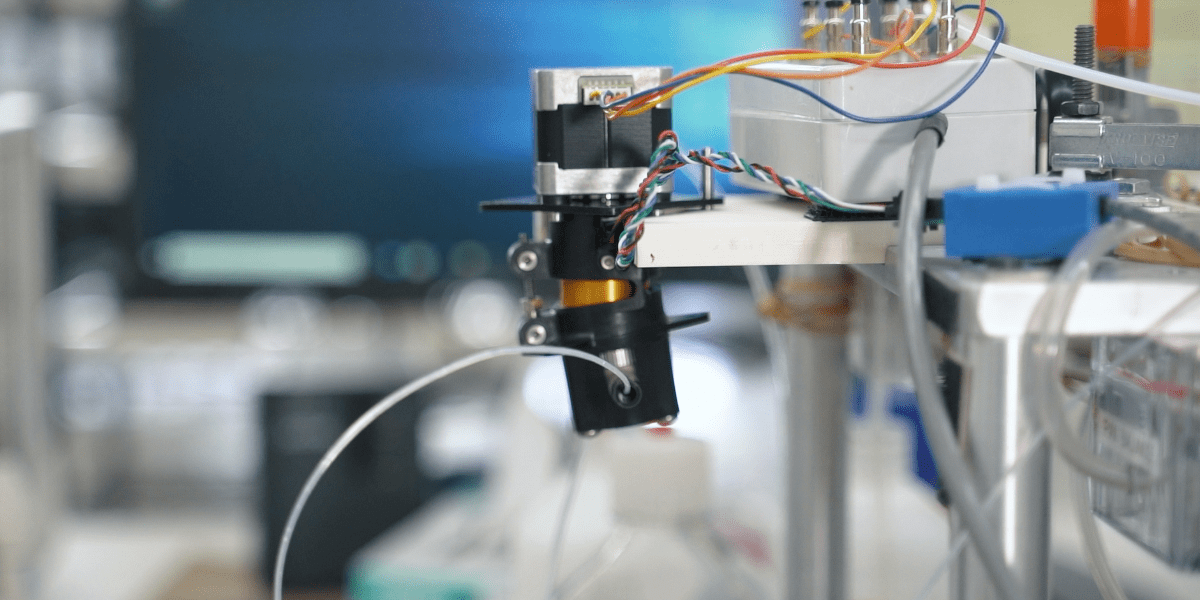1 min read
Configuring a Pump for Non-Contact Dispensing
Key Takeaways: Fluid Metering’s FENYX® pump for non-contact dispensing enables accurate, sterile fluid delivery under 10 µL without tip submersion...
Key Takeaways:
As a mechanical engineer working on the hardware design of IVD platforms for ISO:13485 medical devices, it's essential to understand the different fluidic architectures and their pros and cons. Two popular methods for dispensing fluids accurately and consistently are air over liquid dispense system (aka, time pressure dosing system) and piston pumps.
An air over liquid dispense system is a complex system that dispenses fluids at a specific pressure and time. It uses custom software to calculate the fluid's specific gravity, pressure sensors upstream and downstream to measure the pressure, and dispenses the required volume on the fly. While this system is suitable for many industries, including pharmaceuticals, food, and cosmetics, it can be a nightmare to integrate into manufacturing. The precision tips can become clogged as the pressure changes constantly. Recalibration is often required, resulting in downtime and waste in dispensing, which can be costly if expensive reagents or buffer fluids are used.
An air over liquid dispense system also comprises approximately eight separate components that must work together, including a pressure pump, transfer pump, purging pump, pressure controller, software, pressure accumulator, dispense valve, and pressure sensor. If one of these components fails, the entire system can fail, and it can be challenging to diagnose the issue in final assembly. Additionally, if fittings are used, there are potentially 17 different leak points, including leak points on the pressure controller, pressure accumulator, dispense valve, tee for the pressure sensor, and pressure pump.
When using a custom manifold, burrs can also be challenging to identify and find, leading to difficulties in final testing. Stack-up tolerance can also be a problem as dimensional variations or deviations can accumulate when several components are assembled or mated together, leading to variations in the final product's dimensions or performance. Furthermore, air over liquid dispensing requires constant pressure from a pump, which can be noisy and negatively impact the pump's life.
Other factors to consider:
On the other hand, a valveless piston pump, such as the Fluid Metering FENYX® Variable Dispense Pump (formerly FVD), has only four wetted components and is a better fit for critical ISO:13485 applications. The risk to the design significantly decreases, and the overall reliability of the design increases by using only one device with two moving components. FENYX Pump does not require a separate priming or flushing pump, allowing for a simplified fluidic architecture and software design. Also, the angle change of FENYX pump could allow for a quicker start up time by handling the priming, flushing, and dispensing within one unit. Similarly, the low number of moving components also promotes a quieter operation, typically between 40 and 50 dB. Furthermore, limited number of interaction points between the reservoir and dispense site (only inlet and outlet of pump head) is less prone to clogging, and with fewer parameters to manage (1) maintaining rotary speed and acceleration, (2) maintaining pump head angle diminishes the need for endless recalibration, resulting in less downtime and waste. Reliability of FENYX Pump has been demonstrated through minimal dispense drift over millions of cycles with verification consisting of 5 million dispenses and 2 million angle changes.
In conclusion, when choosing between an air over liquid dispensing system and a piston pump for the hardware design of an IVD platform, it's crucial to consider the pros and cons of each. While an air over liquid dispensing system may be suitable for some industries, it can be challenging to integrate into manufacturing and can be prone to failure. A valveless piston pump, such as Fluid Metering's FENYX Variable Dispense Pump, is a better fit for critical ISO:13485 applications and has a lower risk of failure and higher overall reliability.

1 min read
Key Takeaways: Fluid Metering’s FENYX® pump for non-contact dispensing enables accurate, sterile fluid delivery under 10 µL without tip submersion...

Key Takeaways: For monomer dispensing in contact lens manufacturing, Fluid Metering’s valveless piston pumps deliver ±0.5% accuracy and consistent...

1 min read
Key Takeaways: In precision liquid dispensing systems, initial drops are often discarded due to air bubbles, surface tension, and residual fluid—but...